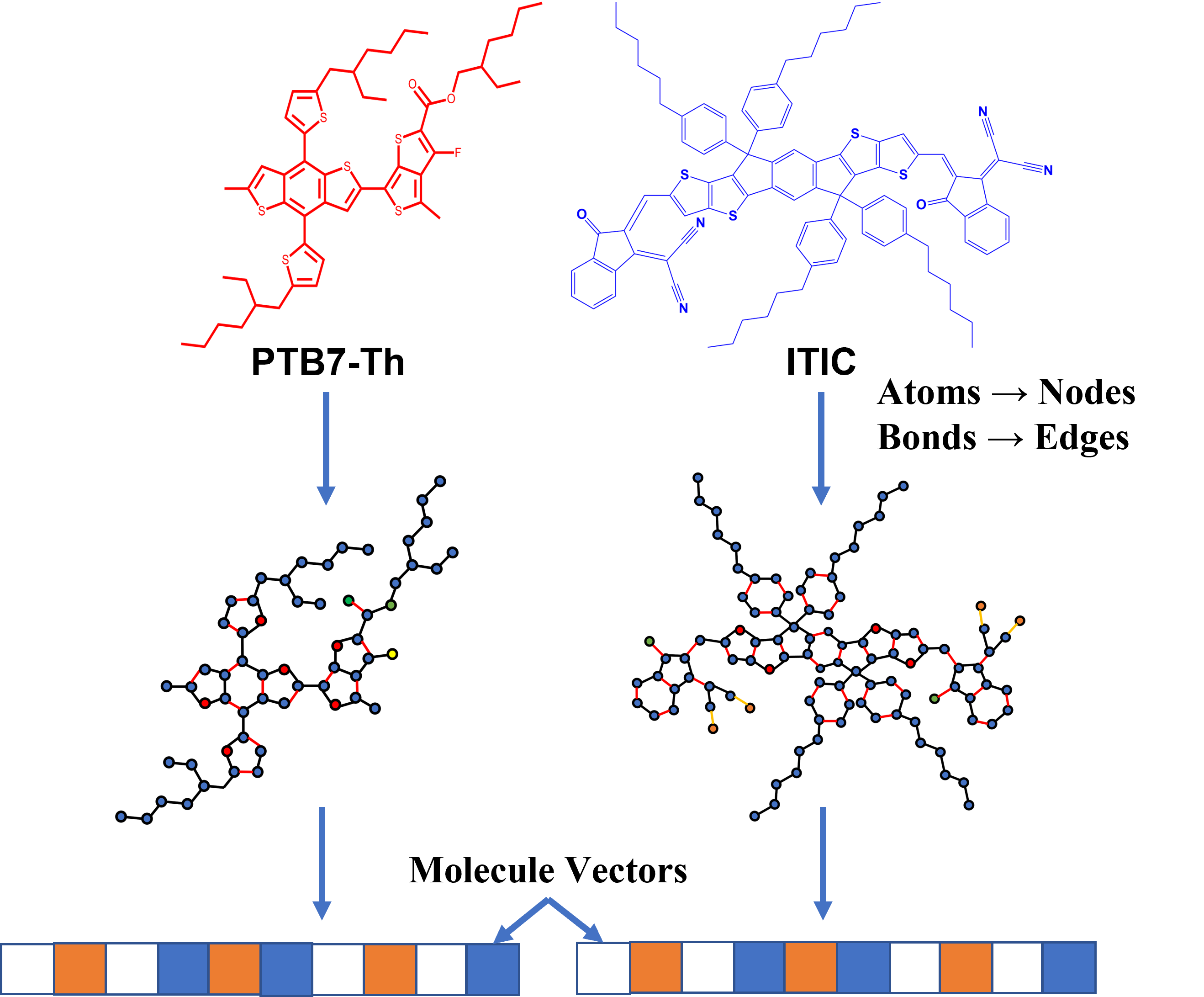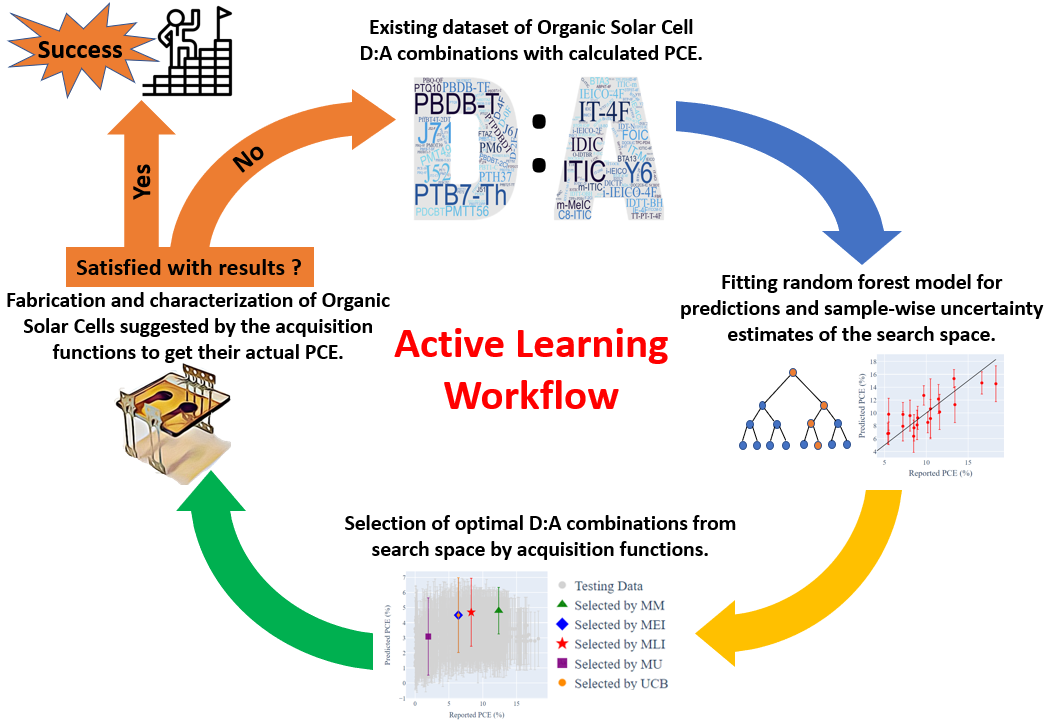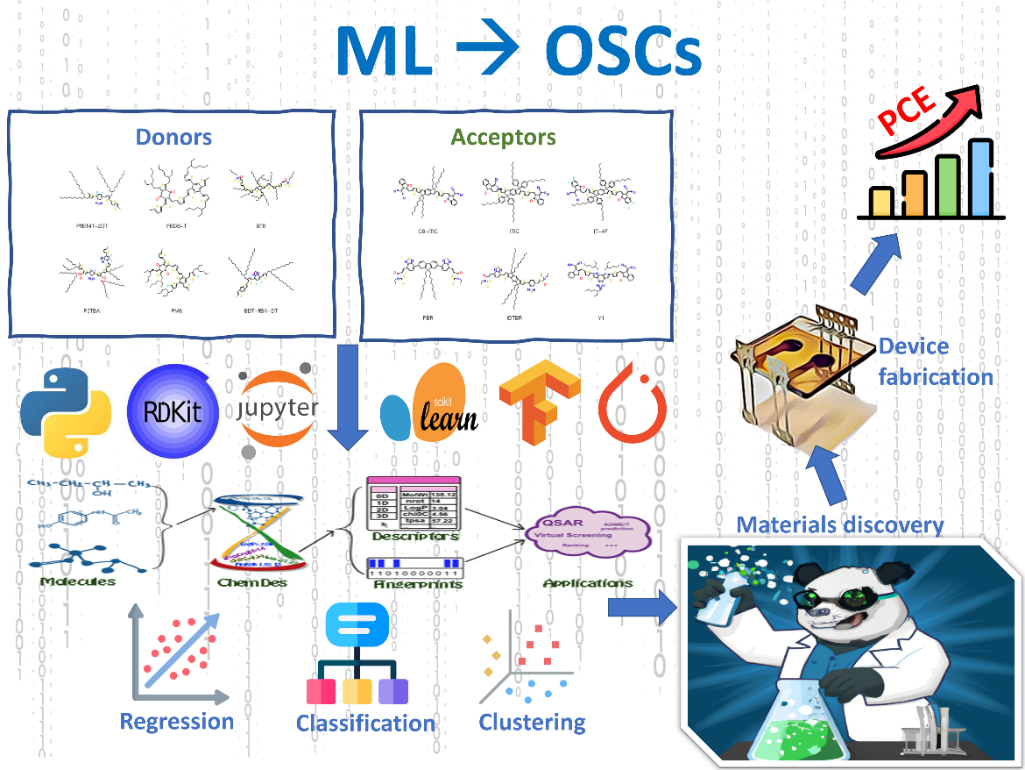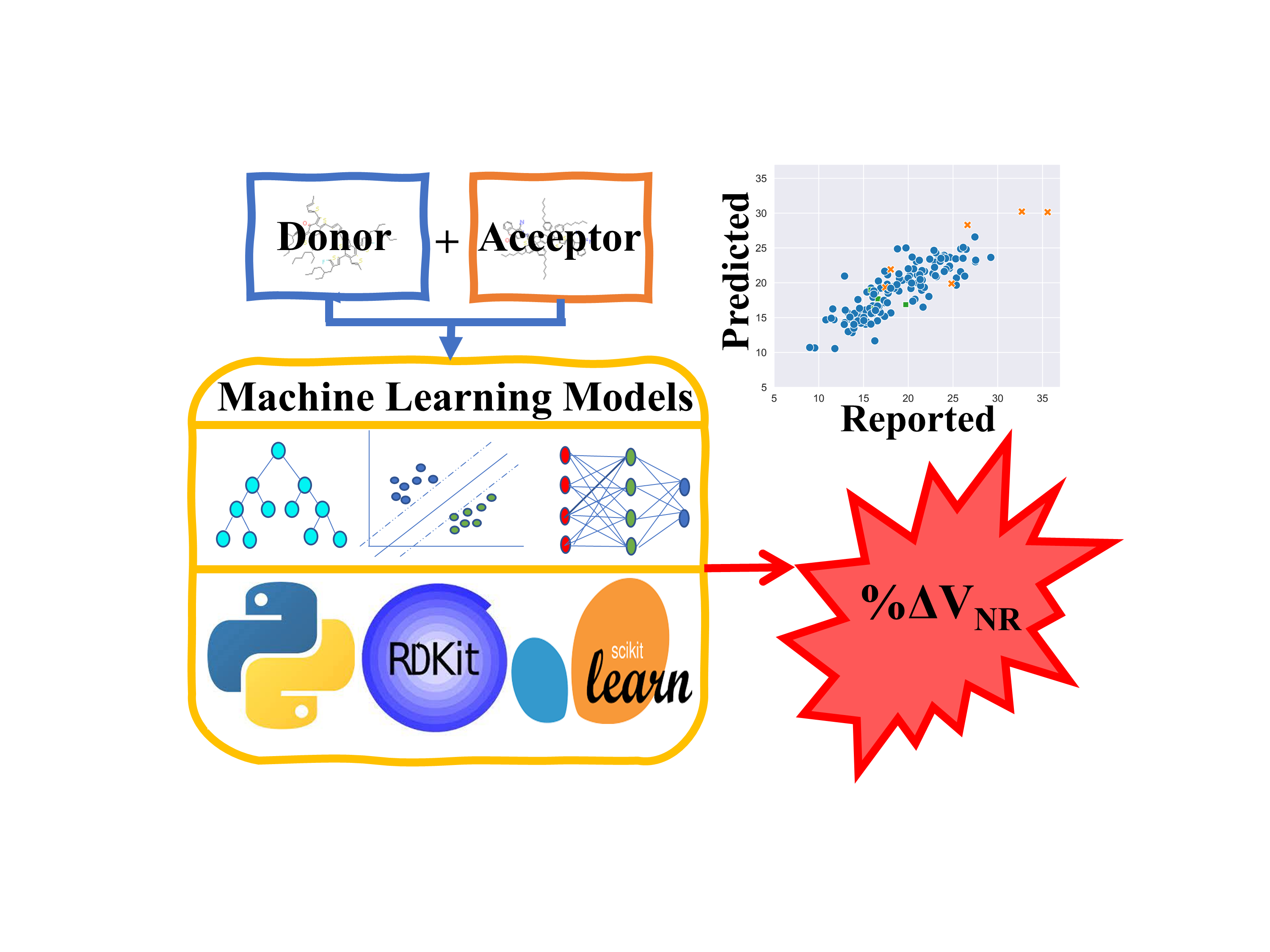Publications
Directed Message Passing Neural Network for Predicting Power Conversion Efficiency in Organic Solar Cells
Journal: ACS Applied Materials and Interfaces
Publication Date: July 25, 2023
 Organic solar cells (OSCs) have emerged as a promising technology for renewable energy generation, and researchers are constantly exploring ways to improve their efficiency. For prediction of photovoltaic properties in OSCs, many machine learning models have been used in the past. All the models are used with fixed molecular descriptors and molecular fingerprints as input for power conversion efficiency (PCE) prediction. Recently, the graph neural network (GNN), which can model graph structures of the molecule, has received increasing attention as a method that could potentially overcome the limitations of fixed descriptors by learning the task-specific representations using graph convolutions. In this study, we have used the directed message passing neural network (D-MPNN), an emerging type of GNN for predicting PCE of organic solar cells, and the results are compared for the same train and test set with fixed descriptors and fingerprints. The excellent performance demonstrated by the D-MPNN model in this investigation highlights its potential for predicting PCE, surpassing the limitations of conventional fixed descriptors.
Organic solar cells (OSCs) have emerged as a promising technology for renewable energy generation, and researchers are constantly exploring ways to improve their efficiency. For prediction of photovoltaic properties in OSCs, many machine learning models have been used in the past. All the models are used with fixed molecular descriptors and molecular fingerprints as input for power conversion efficiency (PCE) prediction. Recently, the graph neural network (GNN), which can model graph structures of the molecule, has received increasing attention as a method that could potentially overcome the limitations of fixed descriptors by learning the task-specific representations using graph convolutions. In this study, we have used the directed message passing neural network (D-MPNN), an emerging type of GNN for predicting PCE of organic solar cells, and the results are compared for the same train and test set with fixed descriptors and fingerprints. The excellent performance demonstrated by the D-MPNN model in this investigation highlights its potential for predicting PCE, surpassing the limitations of conventional fixed descriptors.
Prateek Malhotra, Subhayan Biswas, and Ganesh D. Sharma. “Directed Message Passing Neural Network for Predicting Power Conversion Efficiency in Organic Solar Cells.” ACS Applied Materials & Interfaces (2023).$|$ 
Active Discovery of Donor: Acceptor Combinations For Efficient Organic Solar Cells
Journal: ACS Applied Materials and Interfaces
Publication Date: December 2, 2022
 Organic solar cells (OSCs) have witnessed significant improvement in power conversion efficiency (PCE) in the last decade. The structural flexibility of organic semiconductors provides vast search space for potential candidates of OSCs, but discovering new materials from search space with traditional approaches such as DFT is computationally expensive and time-consuming. Machine learning (ML) is extensively used in OSCs to accelerate productivity and materials discovery. ML is gaining more attention due to the availability of large datasets, improved algorithms, and exponentially growing computational power. In this review, current progress, opportunity, and challenges for ML in OSCs have been identified. Given the rapid advances in this field, impactful techniques that have been useful in extracting meaningful insights are discussed.
Organic solar cells (OSCs) have witnessed significant improvement in power conversion efficiency (PCE) in the last decade. The structural flexibility of organic semiconductors provides vast search space for potential candidates of OSCs, but discovering new materials from search space with traditional approaches such as DFT is computationally expensive and time-consuming. Machine learning (ML) is extensively used in OSCs to accelerate productivity and materials discovery. ML is gaining more attention due to the availability of large datasets, improved algorithms, and exponentially growing computational power. In this review, current progress, opportunity, and challenges for ML in OSCs have been identified. Given the rapid advances in this field, impactful techniques that have been useful in extracting meaningful insights are discussed.
Prateek Malhotra, Juan C. Verduzco, Subhayan Biswas, and Ganesh D. Sharma. “Active Discovery of Donor: Acceptor Combinations For Efficient Organic Solar Cells.” ACS Applied Materials & Interfaces 14, no. 49 (2022): 54895-54906.$|$ 
Opportunities and challenges for machine learning to Select Combination of Donor and Acceptor Materials for Efficient organic solar cells
Journal: Journal of Materials Chemistry C
Publication Date: July 5, 2022
 Organic solar cells (OSCs) have witnessed significant improvement in power conversion efficiency (PCE) in the last decade. The structural flexibility of organic semiconductors provides vast search space for potential candidates of OSCs, but discovering new materials from search space with traditional approaches such as DFT is computationally expensive and time-consuming. Machine learning (ML) is extensively used in OSCs to accelerate productivity and materials discovery. ML is gaining more attention due to the availability of large datasets, improved algorithms, and exponentially growing computational power. In this review, current progress, opportunity, and challenges for ML in OSCs have been identified. Given the rapid advances in this field, impactful techniques that have been useful in extracting meaningful insights are discussed..
Organic solar cells (OSCs) have witnessed significant improvement in power conversion efficiency (PCE) in the last decade. The structural flexibility of organic semiconductors provides vast search space for potential candidates of OSCs, but discovering new materials from search space with traditional approaches such as DFT is computationally expensive and time-consuming. Machine learning (ML) is extensively used in OSCs to accelerate productivity and materials discovery. ML is gaining more attention due to the availability of large datasets, improved algorithms, and exponentially growing computational power. In this review, current progress, opportunity, and challenges for ML in OSCs have been identified. Given the rapid advances in this field, impactful techniques that have been useful in extracting meaningful insights are discussed..
Prateek Malhotra, Kanupriya Khandelwal, Subhayan Biswas, Fang-Chung Chen, and Ganesh D. Sharma. “Opportunities and challenges for machine learning to select combination of donor and acceptor materials for efficient organic solar cells.” Journal of Materials Chemistry C 10, no. 47 (2022): 17781-17811.$|$ 
Prediction of non-radiative voltage losses in organic solar cells using machine learning
Journal: Solar Energy
Publication Date: November 1, 2021
 One of the major hurdles that are preventing organic solar cells (OSCs) from leading the efficiency chart is non-radiative voltage loss (ΔVNR). So far, however, not much effort is made to predict voltage losses and unravel the correlation of losses with electronic and structural descriptors. From the literature, we create a dataset consisting of 154 unique donor:acceptor combinations with reported ΔVNR. The dataset includes information about frontier molecular orbitals (FMO), optical bandgap (Eg), molecular descriptors, and molecular fingerprints. Four machine learning (ML) algorithms (random forest regressor, gradient boosting regressor, support vector regressor, and artificial neural network) are used to predict non-radiative voltage loss and the results obtained are compared on the basis of Pearson rs, root mean squared errors, and mean absolute percentage errors.
One of the major hurdles that are preventing organic solar cells (OSCs) from leading the efficiency chart is non-radiative voltage loss (ΔVNR). So far, however, not much effort is made to predict voltage losses and unravel the correlation of losses with electronic and structural descriptors. From the literature, we create a dataset consisting of 154 unique donor:acceptor combinations with reported ΔVNR. The dataset includes information about frontier molecular orbitals (FMO), optical bandgap (Eg), molecular descriptors, and molecular fingerprints. Four machine learning (ML) algorithms (random forest regressor, gradient boosting regressor, support vector regressor, and artificial neural network) are used to predict non-radiative voltage loss and the results obtained are compared on the basis of Pearson rs, root mean squared errors, and mean absolute percentage errors.
Prateek Malhotra, Subhayan Biswas, Fang-Chung Chen, and Ganesh D. Sharma. “Prediction of non-radiative voltage losses in organic solar cells using machine learning.” Solar Energy 228 (2021): 175-186.$|$ 
